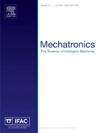Velocity control of actuators in hydraulic manipulators based on a pressure-independent model with application to a telescopic handler
IF 3.1
3区 计算机科学
Q2 AUTOMATION & CONTROL SYSTEMS
引用次数: 0
Abstract
Hydraulic cylinders are critical components in industrial machinery, providing the large actuation forces required for lifting and positioning of heavy loads. Reliable control of hydraulic actuators is a core objective for realization of full automation as well as implementation of assistance functions enhancing efficiency, energy conservation and operational safety. Model-based approaches address the inherent challenges of nonlinear dynamics and varying external influences. However, complex models increase computational effort and the number of required sensors while giving up generality. This work presents the design of a cylinder velocity controller that incorporates a simplified model approximating the highly dynamic hydraulic system behavior. The proposed control scheme requires only cylinder position signals and consists of a feed-forward component effectively compensating the simplified system dynamics in combination with an online implementation of the Linear Quadratic Regulator for state feedback. Desired trajectories for the states of each individual cylinders result from generation of S-curves and are compared to estimated states from an Extended Kalman Filter. The resulting pressure-independent, model-based velocity control method is validated through measurements with a telescopic handler. However, the approach can be expanded and adapted to various hydraulic machinery.
基于压力无关模型的液压机械臂执行器速度控制,并在伸缩式机械手中的应用
液压缸是工业机械中的关键部件,为提升和定位重物提供了巨大的驱动力。液压执行机构的可靠控制是实现全自动化和辅助功能的核心目标,提高了效率、节能和运行安全。基于模型的方法解决了非线性动力学和变化的外部影响的固有挑战。然而,复杂模型在放弃通用性的同时增加了计算量和所需传感器的数量。这项工作提出了一个气缸速度控制器的设计,它包含了一个近似高动态液压系统行为的简化模型。所提出的控制方案只需要气缸位置信号,并由有效补偿简化系统动力学的前馈组件与状态反馈的线性二次型调节器的在线实现相结合组成。每个柱体状态的期望轨迹由s曲线生成,并与扩展卡尔曼滤波器估计的状态进行比较。通过伸缩式手柄进行测量,验证了与压力无关、基于模型的速度控制方法。然而,该方法可以扩展和适应于各种液压机械。
本文章由计算机程序翻译,如有差异,请以英文原文为准。
求助全文
约1分钟内获得全文
求助全文
来源期刊

Mechatronics
工程技术-工程:电子与电气
CiteScore
5.90
自引率
9.10%
发文量
0
审稿时长
109 days
期刊介绍:
Mechatronics is the synergistic combination of precision mechanical engineering, electronic control and systems thinking in the design of products and manufacturing processes. It relates to the design of systems, devices and products aimed at achieving an optimal balance between basic mechanical structure and its overall control. The purpose of this journal is to provide rapid publication of topical papers featuring practical developments in mechatronics. It will cover a wide range of application areas including consumer product design, instrumentation, manufacturing methods, computer integration and process and device control, and will attract a readership from across the industrial and academic research spectrum. Particular importance will be attached to aspects of innovation in mechatronics design philosophy which illustrate the benefits obtainable by an a priori integration of functionality with embedded microprocessor control. A major item will be the design of machines, devices and systems possessing a degree of computer based intelligence. The journal seeks to publish research progress in this field with an emphasis on the applied rather than the theoretical. It will also serve the dual role of bringing greater recognition to this important area of engineering.
 求助内容:
求助内容: 应助结果提醒方式:
应助结果提醒方式:


